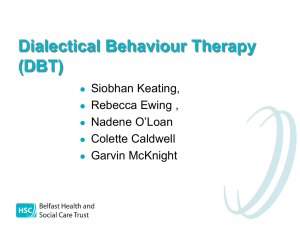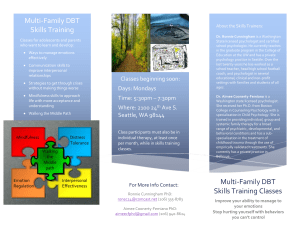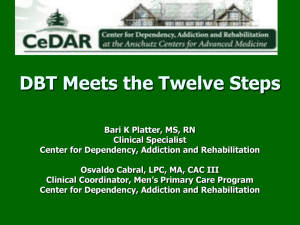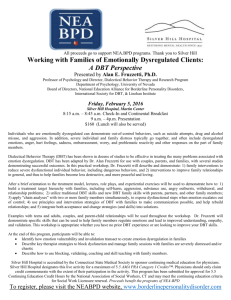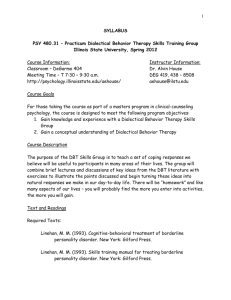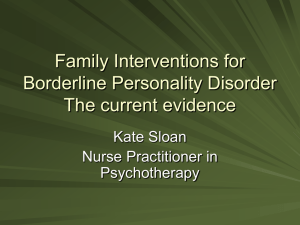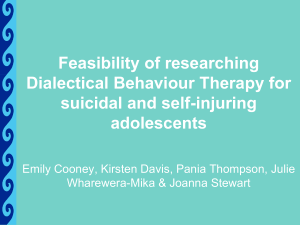Dr. Paulette Aasen`s presentation on DBT
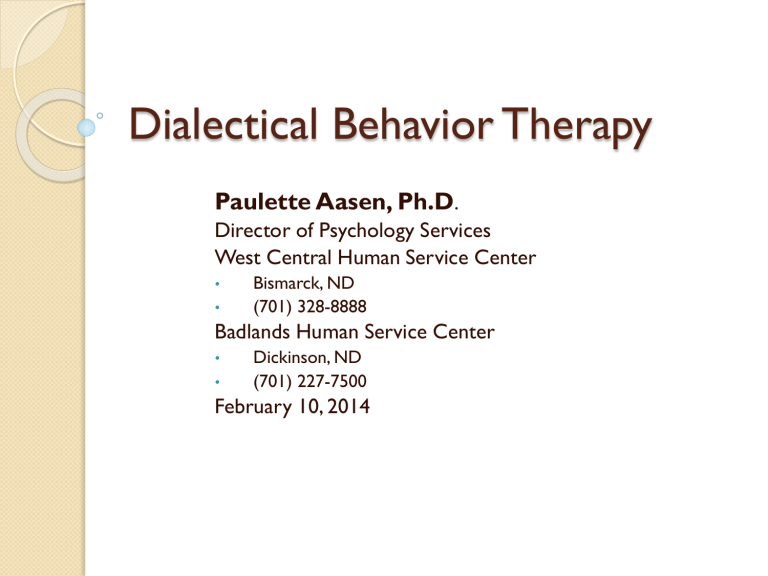
Dialectical Behavior Therapy
Paulette Aasen, Ph.D
.
•
Director of Psychology Services
West Central Human Service Center
Bismarck, ND
•
• (701) 328-8888
Badlands Human Service Center
Dickinson, ND
• (701) 227-7500
February 10, 2014
Overview of DBT
Developed by Marsha Linehan, Ph.D., in 1993 as treatment for clients struggling with severe & persistent emotional, behavioral, & thought difficulties, especially those diagnosed with
Borderline Personality Disorder.
Dr. Linehan recently shared that she struggles with Borderline Personality Disorder.
The Goal of DBT: “Create a life worth living.”
Foundations of DBT
DBT is a synthesis of three paradigms:
◦ Dialectics
◦ Behaviorism
◦ Mindfulness
Purpose:
◦ Reducing dysfunctional behaviors
◦ Increasing skillful behaviors
◦ Building a life worth living
Client needs validating environment in which s/he is taught to regulate emotions, deal with interpersonal conflicts, tolerate distress, and find balance.
Swenson, Witterholt, & Bohus, 2007
Linehan Diagnosis for
Borderline Personality Disorder
Emotion Dysregulation
◦ Affective lability
◦ Problems with anger
Interpersonal Dysregulation
◦ Chaotic relationships
◦ Fears of abandonment
Self Dysregulation
◦ Identity disturbance – difficulties with sense of self
◦ Sense of emptiness
Behavioral Dysregulation
◦ Parasuicidal behavior
◦ Impulsive behavior
Cognitive Dysregulation
◦ Dissociation / paranoid ideation
(Linehan, 1993)
Bio-Social Model
Biological Sensitivity
AND Invalidating Environment =
Dsyregulation Disorder Symptoms
Invalidating
Environment Invalidating
Environment
Invalidating
Environment
Biology
Biology
Biology
Bio-Social Model (cont.)
High Sensitivity
High Reactivity
Slow Return to Baseline
Often “Transactional” with the
Environment
6
5
4
3
2
1
0
9
8
7
Slow Return to Baseline
Average
Dysregulated
Threshold
Dialectical Paradigm
Dialectics is the theory that opposites can co-exist.
• Hegel: “Process of change in which a concept or its realization passes over into and is preserved and fulfilled by its opposite.”
• Bohr: “The Universe is so constructed that the opposite of a true statement is a false statement, but the opposite of a profound truth is usually another profound truth.”
Dialectical Paradigm
From DBT Self Help at http://www.dbtselfhelp.com
Dialectics: A Model for Change
Thesis
Antithesis
Synthesis
Movement Over Time
Primary Dialectic in DBT
Acceptance Change
Dialectical Dilemmas
Emotional
Vulnerability
Unrelenting
Crisis
Active
Passivity
Biological
Social
Apparent
Competence
Self-Invalidation
Inhibited
Experiencing
Dialectical Strategies
Balance Treatment Strategies
Enter the paradox
Metaphor
Devil’s Advocate
Extending
Wise Mind
“Lemonade out of lemons”
Allowing natural change
Dialectical Assessment
Behaviorism Paradigm
From DBT Self Help at http://www.dbtselfhelp.com
Behavior Therapy Basics
Behavioral Principles necessary to be effective
Behavior Therapy: a non-biological form of therapy that developed from learning theory. The purpose is to change maladaptive patterns of behavior.
Shaping: Divide a behavior to be learned into a series of steps.
DBT: Harm reduction model so shape clients toward that
DBT Assumptions about Clients
Clients are doing the best they can.
Clients want to improve.
Clients need to do better, try harder, and be more motivated to change.
Clients may not have caused all of their own problems, AND they need to solve them anyway.
Assumptions about Clients (cont.)
The lives of suicidal individuals with
Borderline Personality Disorder are unbearable as they are currently being lived.
Clients must learn new behaviors in all relevant contexts.
Clients cannot fail in DBT.
Assumptions About Therapy
The most caring thing a therapist can do is help clients change in ways that bring them closer to their own ultimate goals.
Clarity, precision, and compassion are of utmost importance in conducting DBT.
The therapeutic relationship is a real relationship between equals.
Hierarchy of Targets
Individual Therapy
1.
Life threatening behaviors
2.
Therapy interfering behaviors
3.
Quality of life interfering behaviors
4.
Increasing behavioral skills
Client Agreement
Client and Therapist BOTH sign the agreement to acknowledge what it is they are agreeing to in the therapy relationship.
Session Structure
Review Diary Card
Attention to Target Hierarchy
Chain Analysis on highest targeted behavior
Weave in Solution Analysis
Continue to move down hierarchy until able to discuss skills related to current life situations or session time ends
Commitment Strategies
Therapist discusses PRO’s and CON’s of commitment to change
Use the DEVIL’S ADVOCATE technique to strengthen commitment and build sense of control
Highlight PRIOR COMMITMENTS consumer has made
Present consumer with CHOICE stressing the freedom to choose while presenting the consequences of choices clearly and directly
Commitment Strategies (cont.)
Therapist uses principles of SHAPING to elicit commitment
Therapist generates hope by
CHEERLEADING
Therapist and client agree on
HOMEWORK
Validation of Consumer
Stay Awake
Accurate Reflection
Articulating unverbalized emotions, thoughts, and behavior patterns
Validation in terms of past learning or biological dysfunction
Validation in terms of current context or normative functioning
Radical Genuineness
Self-Verification Theory
Validation = Self-Verification
Invalidation of Self-Construct leads to
AROUSAL!!! (Sense of out-of-control)
HIGH AROUSAL + OUT-OF-
CONTROL leads to >>>>
Failure to process New Information
=
NO NEW LEARNING!
Relationship Strategies
Accept the relationship as it is in the current moment, use the relationship as therapy – YOU are the Key
Use problem solving on the relationship
Attend directly to generalization of behaviors learned in the relationship
Be honest about limits
Be consistently firm
Combine Soothing, Validating, & Problem
Solving with Observing Limits
Warm Engagement:
◦ Limits on Warmth
◦ Coping with anger/rage at the consumer
◦ Warm engagement and touch in psychotherapy
Genuineness
DBT Skills Group
Screening session
1-year commitment
Both client and therapist sign agreement
Agreement includes statements regarding homework completion and attendance
Co-facilitators
Hierarchy of Targets
DBT Skills Group
1.
Therapy destroying behavior
2.
Skills acquisition, strengthening, and generalization
3.
Therapy interfering behaviors
Zen Practice
Be Mindful to the current moment
See reality as it is without delusions
Accept reality without judgment
Focus on one’s own experiencing as a means of understanding the world
Let go of attachments that obstruct seeing and accepting reality as it is
Use skillful means
Find the middle way
Mindfulness Paradigm
Mindfulness is at the core of
◦ Emotion Regulation (emotions, thoughts, and behaviors).
◦ Distress Tolerance (skills used to help us cope and survive during a crisis, distracting or soothing activities).
◦ Interpersonal Effectiveness (skills which help us to attend to relationships, balance priorities versus demands, balance the “wants” and the “shoulds,” and build a sense of mastery and self-respect.
From DBT Self Help at http://www.dbtselfhelp.com
Mindfulness
“Paying attention on purpose, in the present moment, and nonjudgmentally to the unfolding of experiences moment by moment.”
(Kabat-Zinn, 2003, p. 145).
Non-Judgment
Patience
Beginner’s Mind or Child’s Mind
Trust
Non-Striving
Acceptance
Letting Go
Kabat-Zinn, 1990
1.
5 Stages of Accomplishment
Denial I can’t do it!
Maybe I can do it!
2.
Uncertainty
3.
Resistance
There’s no way I can do it!
4.
Panic
AAAARGH!
What if I can’t do it?!
5.
Acceptance
ALL RIGHT!
I DID IT!
LET’S
PARTY!
CONGRATULATIONS!
References
DBT Self-Help Website http://www.dbtselfhelp.com
Kabat-Zinn, J. (1990). Full Catastrophe Living: Using the Wisdom of
Your Body and Mind to Face Stress, Pain, and Illness. New York:
Delacorte.
Linehan, M. (1993). Cognitive-Behavioral Treatment of Borderline
Personality Disorder. New York: Guilford.
Miller, A. L., Rathus, J. H., & Linehan, M. I. (2007). Dialectical Behavior
Therapy for Suicidal Adolescents. New York: Guilford.
Swenson, C. R., Witterholt, S., & Bohus, M. (2007). Dialectical behavior therapy on inpatient units. In: L. Dimeff & K. Koerner
(eds.). Dialectical Behavior Therapy in Clinical Practice. New York:
Guilford.
DBT Associates
Christine Kvidera, MSW, LICW
7362 University Ave. NE, Suite 101
Fridley, Minnesota 55432
Phone & Fax: (763) 503-3981 www.dbtassociates.com
Email: chrisco28@aol.com
